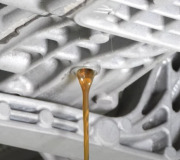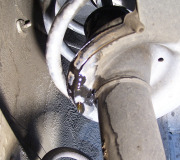Typically when you have to put sideways pressure on a connector for it to work, there's three things to look for. The most common is a stretched or corroded terminal. Most of the time you can slide a pick in beside the terminal to squeeze it to make tighter contact. If it's corroded, you'll need to disassemble the plug, then release a little plastic finger to allow the terminal to be removed, then you can replace it. GM and Chrysler dealers have replacement terminals available. Ford is well-known to not make repair parts available after just a few years so the best alternative is to visit a salvage yard to get a terminal out of a plug. If you have to pick it to make it fit tighter but the plug design prevents you from doing that, you'll have to pull the terminal out, then squeeze it gently with a needle-nose pliers.
The second thing to suspect when you're working with a connector that plugs into a computer or anything with a circuit board is a terminal that is broken loose from the board. To fix that you have to get the board out of the housing, and remove any protective jelly, if that is used, then resolder the terminal to the board. TV repairmen ran into this every day once tvs started to be made with automated assembly techniques.
A less-common problem is a break in the wire just outside of where it is crimped to the terminal. Sometimes a clue presents itself where the wire's insulation is slightly discolored right next to the terminal. To verify that, hold the plug while you tug gently on the wire. If the wire is broken inside the insulation, that insulation will stretch like a stiff rubber band.
Wednesday, March 23rd, 2016 AT 5:48 PM



